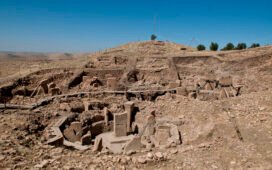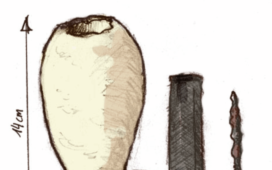There isn’t much place for dodecahedra in modern life, at least in those modern lives with tabletop role-playing. In the ancient Roman Empire, however, those shapes seem to have been practically household objects — not that we know what the household would have done with them. Thus far, well over 100 similarly designed copper-alloy second-to-fourth-century artifacts labeled “Roman dodecahedra” have been discovered: the first was unearthed in 1739, and the most recent just two years ago. With their complex structure, knobbed corners, and (in some cases) surface designs, their construction would have required a skilled metalworker. Perhaps they were the result of professional examination, premised on the idea that a man who can make a proper dodecahedron can make anything.
That’s one theory, if only one of many. In the video above, Joe Scott goes over a variety of them, explaining why amateurs and experts alike have proposed that the Roman dodecahedron was everything from a military rangefinder to a sundial calendar to a decoder to a measuring device to a coin validator to a ritualistic amulet to a “Roman fidget spinner.”
One particularly compelling explanation holds that it was an aid for a chain-making technique called “Viking knitting,” which would at least make sense given that all extant examples have come from northern Europe. Yes, no Roman dodecahedron has ever been found in Rome, or even in the whole of Italy, and that’s far from the most confusing fact about these still-mysterious objects.
The proposition that the Roman dodecahedron was a knitting aid, especially if it was used for making chain, is undercut by the lack of wear on all known examples. Military or technical applications are also made somewhat implausible by the absence of numerals or other markings. While some Roman dodecahedra have been dug up from army camps, many more came from the tombs of upper-class women, suggesting that they had more value as a status symbol than a practical tool. Most bewildering of all is the fact that no texts or images from the period make any reference to the things, which Scott takes as evidence for their being so common as not to merit discussion — much like, say, the icebox doors or telephone shelves built into nineteenth and early twentieth-century houses. At this point, can we really rule out the notion that the Romans made them as a prank on the far-future inheritors of their civilization?
Related Content:
Archaeologists Discover a 2,000-Year-Old Roman Glass Bowl in Perfect Condition
The “Dark Relics” of Christianity: Preserved Skulls, Blood & Other Grim Artifacts
Explore a Digitized Edition of the Voynich Manuscript, “the World’s Most Mysterious Book”
Based in Seoul, Colin Marshall writes and broadcasts on cities, language, and culture. His projects include the Substack newsletter Books on Cities and the book The Stateless City: a Walk through 21st-Century Los Angeles. Follow him on the social network formerly known as Twitter at @colinmarshall.















